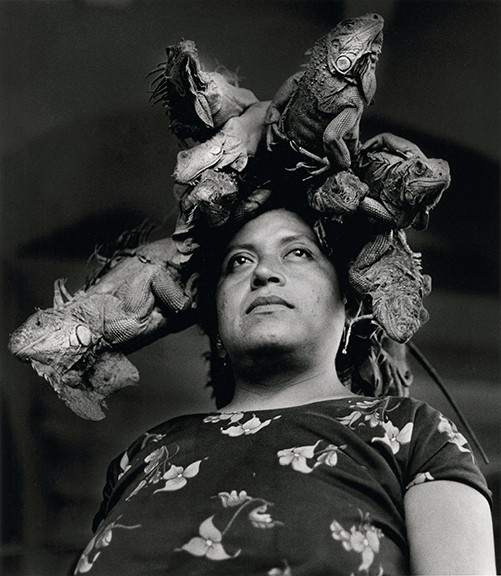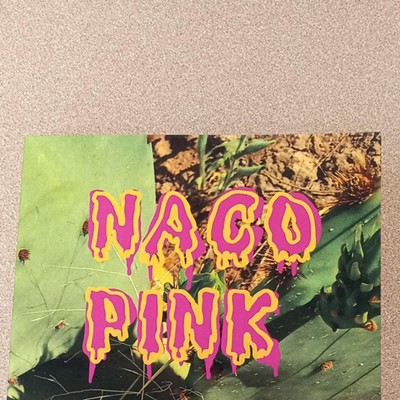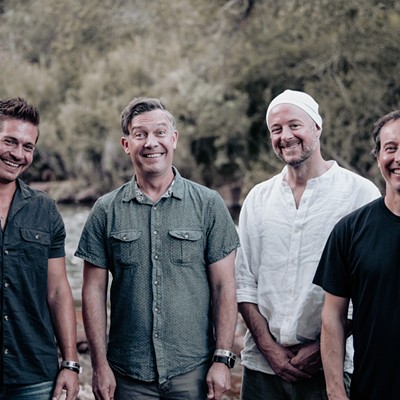Graciela Iturbide took her first photograph high above the clouds.
Flying on her first-ever plane ride, leaving home for the first time, she was on her way to boarding school. She had her first camera too, a Brownie, a going-away gift from her father, an amateur photographer. Looking out the window, young Graciela was entranced by the views of the earth below and the clouds above. She aimed her new camera at the blurry divide between land and sky, and clicked.
The joy of flight stayed with her. Whenever she takes a photo, she would later say, "I become [a] bird in the heavens...The camera awakens wings and the wings give me new eyes."
The renowned photographer, now in her mid-70s, is one of three distinguished photographers in Mementos, a must-see exhibition of black-and-white works at Etherton closing March 3.
Iturbide is best known for her stunning portraits of indigenous women in her native Mexico, and they are here in abundance, including the famous "Nuestra Señora de las iguanas, Juchitán," Mexico, 1979, and "Mujer ángel, Desierto Sonora, Mexico," 1979. But birds sail through many of her poetic images.
In "El Señor de los pájaros, Nayarit," 1985, a rural man looks up with pure pleasure at the sea terns soaring above his head. He's nearly dwarfed by the flock—and by the expansive white sky.
A trio of birds cavorting in the big sky takes up most of the space in "Perros perdidos, Rajasthan, India," 1998; the lost dogs in question are confined to a dark sliver of land below. In this desolate image, the circling birds look like predators, hoping somehow for an animal meal.
Elsewhere, black birds alight on the arms of a dense Mexican saguaro. And in "Pájaros con poste, Guanajuato," 1990, so many birds are flying above a telephone pole they blacken the sky.
Birds, sometimes noticed, sometimes not, are like little messengers from the natural world all around us, too often ignored. For Iturbide, as she said, they also signify the ability to fly freely, to create art.
She was born in 1942 to a well-off family that didn't necessarily favor careers for women. Though she started young that dazzling day in the sky, she didn't pursue photography seriously until 1970, after she married, had three children and suffered the death of her 6-year-old daughter. She worked for a time with the renowned photographer Manuel Alvarez Bravo, and went on to a distinguished career photographing around Latin America, especially Mexico. And though she photographs many subjects, her photos of indigenous women are some of the most arresting.
"Duelo, Chiapas, México," 1975, pictures three women in deep mourning, wrapped in shawls so dark and big they look like shrouds. Their faces are torn with grief, and Iturbide, who'd known great sorrow, photographs them with grace and compassion. In "Marcha política, Juchitán, Oaxaca," 1984, a woman boldly struts down the streets. Her billowing black dress conjures up the Catrina outfit women wear on Día de los Muertos, linking traditional culture with a modern assertion of rights.
The woman with iguanas on her head also has a duality: She's proud and strong, her head held high, laden though it is with wriggling reptiles. She's even been interpreted as a Medusa, the fierce snake-haired woman of Greek myth. But she's also a real woman, making her way to market to earn her daily bread. In Iturbide's viewfinder, daily life is rendered lyrical. Her photos are poetic visions of the prosaic, artful renditions of the everyday.
Across the gallery from Iturbide's work are the muscular documentary photos of fellow Mexican Rodrigo Moya. Born in 1934, Moya's heyday as a photojournalist was in the 1950s and 1960s (he later became an esteemed writer). He traveled to hot spots around Latin America and made both unnerving action images of soldiers and posed portraits of leaders, including Fidel Castro and Che Guevara.
"Guerrilleros, en la niebla," shot in 1965 deep in the misty jungles of Venezuela, is a close-up of uniformed rebels in the dense brush, all of them armed, all of them staring suspiciously at the photographer. The danger for him—and for them—feels palpable. In a series of "Pistolero" shots in Mexico, a cocky gentlemen crook, dressed in a suit and fedora, twirls his gun. An actual execution, from 1966, is a blurry triptych of three men being shot to death.
But Moya also revels in the sweet side of life. The delightful "Lectoras" series pictures women intently reading newspapers while tending their open-air stores. Another series, beautifully composed in diagonals, lionizes Mexican fishermen poling their boats at sea.
Masao Yamamoto, the youngest of the three photographers, was born in Japan in 1957. A painter before he became a photographer, he makes work that's elusive and spare. His tiny gelatin silver prints are sometimes combined with other media, or toned a faint color. Often they're dark with only a pale, almost indistinguishable figure emerging from the shadows.
The images are drawn mostly from the natural world. Lovely nudes share the space with a comical head-on portrait of a white owl and fiery lava burns at night behind a black volcano. One near-abstraction is a bold geometric rendering of two sets of stairs, black against white.
Like Iturbide, Yamamoto is fond of birds. There's that impish owl, a charming hen parading through sand and shadows, geese paddling across a shimmering lake and even a flock of herons swooping across a pale yellow sky.
[Note: The Iturbide airplane anecdote and the quote from Iturbide are both included in the excellent illustrated book Photographic: The Life of Graciela Iturbide by Isabel Quintero and Zeke Peña, published by Paul Getty Museum, Los Angeles. ©2018 J. Paul Getty Trust.]













